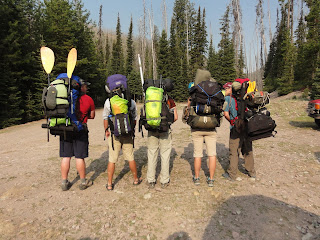 |
| Look how calm that water looks. |
Keep in mind, my friends and I are backpackers turned packrafters. I don't know all the right white-water terms or elementary lessons (as this story will illustrate). I write this for the benefit of others who are new to white-water and particularly to packrafting.
"Go for it! You'll be fine!"
My three friends were beached on the bank opposite my raft. I had planned to pull off on the on my side of the river and we were all going to scout the next rapid, but there wasn't a good spot to beach and the current was going too fast. As I sped along the bank, I shouted back, "Should I just go for it?" As if I had much of a choice at that point.
I managed around the first boulder just fine but the next one was a dewsey. Trying to stall for time to plan my next move I broadsided the boulder and foolishly leaned away. My raft tipped over, the velcro holding my spray skirt to the raft released without me even pulling the handle and bam! I was in the water and on the scariest 2 minute ride of my life.
It turned out, this particular section of class 3ish rapids had no real recovery area. The current was strong and the energy I had was sapped by trying to stay afloat after each successive rapid and small water-fall. I was able to keep my feet forward for much of the journey, but managed to bang my knee up pretty good on a couple boulders. My friend Seth, who had started soon after me, but did not see my spill, caught up with me at an eddy the marked the end of the 150 yard section. I was so exhausted and out of breath, it was all I could do to grab the back of his packraft as he towed me to shore.
Fortunately the temperature was still in the 60s and after putting on some of Seth's dry clothes and doing some jumping jacks my body heat began to return. For everyone else however, the adventure was far from over. Seth ended up being the only one to make it through without going for a swim.
 |
| Shivering after the last rapid |
Benn, the third member of the group, anticipating the spill potential of the rapid made an attempt to pull over near the boulder that ejected me. His raft was suddenly sucked down under a different boulder. He pulled himself out but it took deflating the raft and a great deal of tugging to get the raft out from under the rock (the 6-point elk shed tied on the front of the raft didn't make things easier).
Tyler, the final member of the party was able to get through the section that tipped Benn and I, but was dumped on a different boulder. He was able to get to shore with his raft, regroup and go through the final 4-foot waterfall on his raft.
Needless to say, once we had retrieved all the rafts and paddles, we packed everything up and started the 7-mile hike out (we were pretty close to our planned destination).
Lessons Learned
After a few days of reflection, I think the most important take-away from this adventure is scouting. Followed closely by staying in a tight group when going through rapids. If you scout rapids, you can get through them better and/or make better decisions about whether or not to portage around them. If you stay in tight groups, it is easier to pull over as a group and if you do go into a gnarly section of rapids, you can bail each other out (particularly if you have a throw rope). One final note, if you're new to white-water, it is better to hone your skills on sections of rapids with many recovery areas. It allows you time to think through your next move, or if you are dumped it allows you to get to shore and re-group.
 |
| Amazing views early in the day! |














